

Community Safeguarding Handbook
AISC Core
Our Vision
A community where diverse paths meet, learners innovate, and we make meaningful change together.
Our Mission
Together, we nurture learners who chart their unique paths, transforming curiosity into purpose, challenges into growth, and knowledge into action.
Our Values
#Discovery
#Wellbeing
#Responsibility
#Purpose
#Belonging
De nition of Learning
Learning is a transformative, re ective process of building understanding, empowering learners to think deeply, innovate, collaborate, and act with purpose.
VISION FOR AN AISC LEARNER

Critical Thinkers
De ne, analyze, evaluate, and solve complex problems.
Resilient Learners
Embrace challenges, persist through di culties, learn from feedback, and adapt to new situations.

E ective Collaborators
Collaborate with empathy while learning from and with each other.


Skillful Communicators
Communicate clearly and purposefully across diverse contexts and media.

Digital Navigators
Leverage technology creatively, responsibly, and ethically.
Change Makers
Transfer and apply skills, knowledge, and understanding to make a di erence locally and globally.







AISC Language Philosophy
Community Safeguarding Handbook 2025 - 2026 oC m m uni t y
Teachers instruct & assess in English.
membersinteract with each otherusingacommon l a n gau eg .
Students use any resource, linguistic or otherwise, to be successful.

KOREAN
FRENCH
Philosophie linguistique de l’AISC


. Les enseignants enseignent et évaluent en anglais.
seL mem b r e s d e l a communautéinteragissent les uns aveclesautresaumoyen
Les apprenants sont libres du choix des ressources, linguistiques ou autres, pour réussir.







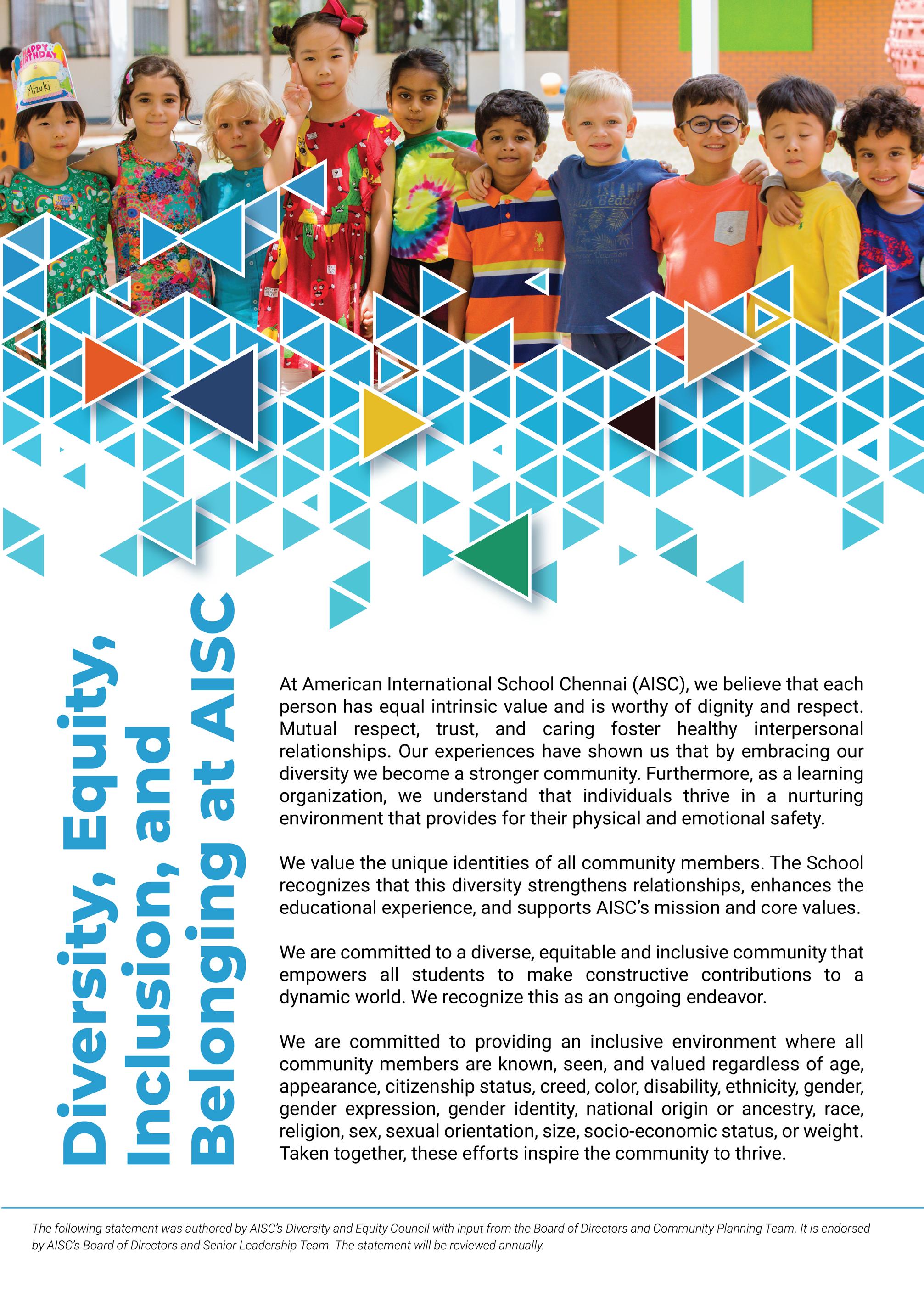
Introduction: Purpose and Scope
Safeguarding is a primary responsibility of schools in all contexts across the globe. The American International School Chennai (AISC) takes this responsibility seriously and pledges to make sure that all appropriate plans and measures are taken to ensure students, employees, and community safety at all times. AISC is committed to integrity, compassion, and self-reflection in the area of safety.
The AISC community has a shared moral and legal responsibility to safeguard the safety of our students, employees and community members. This handbook details the steps required to care for our community, minimize the threat of abuse and harm in our school, and respond promptly and effectively should abuse be observed, suspected, or disclosed. Our safeguarding program will be composed of the following:
1. Recognizing, responding to, and reporting allegations and suspicions of child abuse or neglect;
2. Screening and selecting employees;
3. Training and education about child abuse and neglect prevention;
4. A safeguarding code of conduct that guides interactions between adults and students;
5. Ensuring safe environments and practices;
6. Connecting to local authorities and resources; and
7. Ensuring student-to-student safety.
Schools should be places where all students feel safe. We want to prevent any form of student abuse before it happens, and ensure timely and appropriate detection, intervention, and reporting in the unfortunate event that it should occur.
Our intention is to ensure that if child abuse or neglect is suspected, observed, or disclosed to any member of the AISC community, that person will have the knowledge, information and resources necessary to make sure that the student is safe, the situation is communicated promptly and effectively, and that the suspicion or incident is reported to the appropriate persons, immediately.
In keeping with our Mission, and best practices in governance policies in international schools, the AISC Board of Directors has adopted a Student Protection Policy. This policy assures that we maintain this handbook and that we help guide our school toward safer, more effective, and clearer practices to safeguard the health and welfare of our students.
Definitions
• Child Protection: Child protection refers to the measures and actions taken to prevent and respond to instances of abuse, neglect, exploitation, or harm towards children. It involves identifying and addressing risks to ensure the safety, wellbeing, and rights of children are protected. Child protection often involves interventions in cases where a child is at risk of, or has experienced, harm, and may include legal, social, and psychological support services. Child protection is reacting to harm that has occurred and putting steps into place to protect the individual from further harm.
• Safeguarding: Safeguarding encompasses a broader range of measures aimed at promoting the welfare, safety, and protection of individuals, particularly children and vulnerable adults. Unlike child protection, which focuses on responding to specific instances of harm, safeguarding involves preventing harm from occurring in the first place. It includes creating safe environments, implementing policies and procedures, raising awareness, and providing education and support to ensure the wellbeing of individuals. Safeguarding is all about being proactive in all aspects of the school to reduce risks of harm occurring.
Policy Framework
AISC Student Protection Policy (8.401)
It is the goal of the American International School Chennai to maintain a school environment for all students free from abuse. AISC endorses the United Nations Convention on the Rights of the Child, of which the host country, India, is a signatory and seeks to be a safe haven for students. AISC will also remain compliant with the Protection of Children from Sexual Offences Act, 2012 (POCSO) and the rules therein as well as Guidelines issued by the Government of Tamil Nadu on student safety. No AISC employee may engage in any activity constituting abuse. AISC employees must report to the appropriate authorities any suspected abuse either in or out of school.
According to the World Health Organization, child abuse constitutes, “all forms of physical and/or emotional ill-treatment, sexual abuse, neglect or negligent treatment or commercial or other exploitation, resulting in actual or potential harm to the child’s health, survival, development or dignity in the context of a relationship of responsibility, trust or power.”
Safeguarding and Inclusivity
At American International School Chennai (AISC), we believe that each person has equal intrinsic value and is worthy of dignity and respect. Mutual respect, trust, and caring foster healthy interpersonal relationships.
• Our experiences have shown us that by embracing our diversity we become a stronger community. Furthermore, as a learning organization, we understand that individuals thrive in a nurturing environment that provides for their physical and emotional safety.
• We value the unique identities of all community members. The School recognizes that this diversity strengthens relationships, enhances the educational experience, and supports AISC’s Mission and Core Values.
• We are committed to a diverse, equitable and inclusive community that empowers all students to make constructive contributions to a dynamic world. We recognize this as an ongoing endeavor.
• We are committed to providing an inclusive environment where all community members are known, seen, and valued regardless of age, appearance, citizenship status, creed, color, disability, ethnicity, gender,
gender expression, gender identity, national origin or ancestry, race, religion, sex, sexual orientation, size, socio-economic status, or weight. Taken together, these efforts inspire the community to thrive.
It is also the goal of the American International School Chennai to maintain a safe and supportive school environment for all students free from harassment, intimidation, and/or bullying, and free from discrimination on account of actual or perceived race, color, creed, ethnicity, national origin, citizenship/ immigration status, religion, gender, gender identity, gender expression, sexual orientation, disability, or weight. AISC believes in provisions for the protection of the safety and support of all students regardless of identity group. (Below is adapted from work by the Council of International Schools and Emily Meadows)
• AISC acknowledges that targeting a person based on identity markers such as race, color, ethnicity, caste, religion, gender identity, gender expression, sexual identity, national origin, citizenship status, socioeconomic status, age, language, or ability constitutes harm and abuse.
• AISC recognizes that marginalized identities are at particular risk for identity-based harm.
• AISC recognizes that, within the same systems where identity-based harm operates, marginalized identities are at higher risk of being targeted for sexual abuse.
• AISC takes responsibility for preventing, interrupting, and correcting identity-based harm.
• Identity-based harm can manifest in many forms including, but not limited to, microaggressions, hate speech, online harassment, child-tochild abuse, physical violence, and social exclusion.
• Staff development will include training and resources on how to recognize and respond to identity-based harm.
• When addressing identity-based harm, approaches that maintain agency and protection for the person who is targeted will be used. Further the approach will work to build responsibility and accountability for the person who has committed the harm; this will be based on best practices that are trauma informed.
AISC Wellbeing Framework
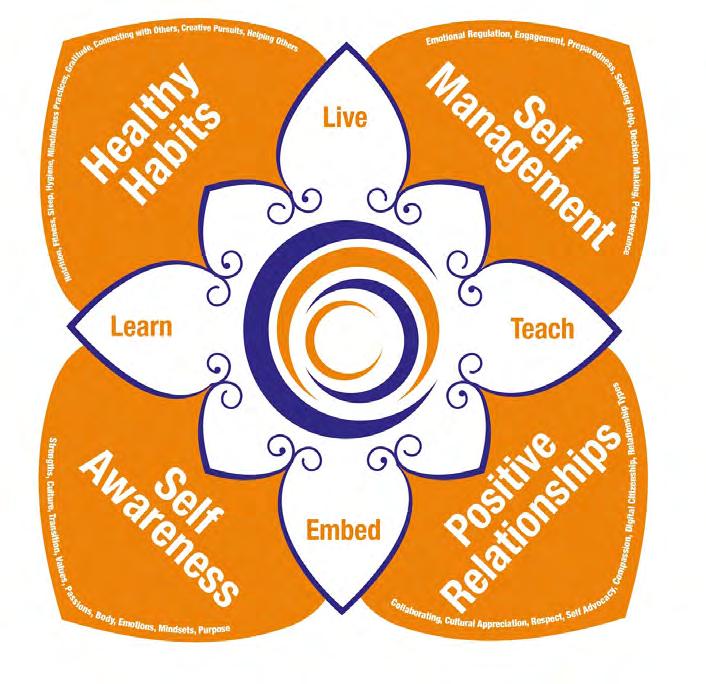
We believe it is our collective responsibility to promote wellbeing with intention to empower community members to thrive. We define wellbeing as feeling good and functioning well. Knowing and taking care of oneself, making positive choices and helping others enables students to flourish.
Context of the AISC Community
Abuse can occur against a background of secrecy, insularity, isolation and limited access to support resources. These factors may be present in international school communities and members of the AISC community should be aware of them in order to better safeguard students. So what are key elements of our socio-cultural context?
1. Our international school students may…
• Be transient and their mobility often impacts the development of their identities and relationships (especially for support in times of need).
• Mature early in some ways and remain naïve in others, especially regarding assumptions about the way things work “back home.”
• Be separated from extended families and known friendships/ relationships, and may have parents who work/travel often which may result in attachment issues. Support during times of crisis or need may be minimal or non-existent.
• Sometimes be caught between multiple and conflicting cultures or value systems, which may create confusion of behavioral expectations.
• Maintain high expectations of themselves to achieve academically.
2. Our international school families may…
• Sometimes be isolated from extended family and community for support.
• Have one or more parents traveling frequently.
• Have conflicted feelings about their host country.
• Sometimes feel a lack of control over critical life decisions: company decides where, when, and how the family moves.
• Sometimes they feel a lack of stability.
3. Our international school communities may…
• See school as a center of family life, which is not always able to provide the level of social, emotional, and psychological support they expect and have available in their home communities.
• Feel isolated as a result of community diversity.
• Feel confused by multiple norms rooted in different cultural traditions vis-a-vis religious values, parenting styles, discipline, care-giving, sexuality, gender roles and responsibilities.
• Feel confused by varying degrees of openness rooted in cultural traditions.
• Experience confusion regarding cultural attitudes toward gender issues and child development of other cultures within the community.
Safeguarding Policy and Procedures
At AISC we recognize that abuse can take many forms and may not always be visible or detectable. Abuse can happen in any of the four areas described below. Prevention is possible and AISC is vigilant in its efforts to protect our community members.
Understanding the Complexities of Abuse and Corporal Punishment
The definitions of abuse are multifaceted, often intertwined with cultural norms, gender roles, and societal expectations across diverse communities globally. These definitions are not static but evolve through the lens of child-rearing practices, familial dynamics, and the influence of various social constructs.
At the core of identifying abuse is the recognition of power dynamics within relationships, whether familial, educational, or peer-based. Abuse manifests when the stronger party exploits this power to fulfill their own needs at the expense of the weaker individual. Extensive research informs these definitions, illuminating the profound impact of certain behaviors on vulnerable individuals.
In AISC, it’s imperative to emphasize that corporal punishment is unequivocally deemed unacceptable as a disciplinary measure for students. Any form of punishment that inflicts physical, emotional, or psychological harm upon a child contravenes our principles of safeguarding. Families will be promptly engaged, and if necessary, authorities may be notified, should any such actions come to our attention.
It’s essential to recognize that while behavioral indicators can be indicative, they alone do not constitute abuse or neglect. Instead, they serve as critical components alongside an understanding of family dynamics and other contextual factors, guiding us in making informed decisions and appropriate referrals when necessary.
Type of Abuse Definition/Information
Physical
Physical injury inflicted by other than accidental means upon a student by another person including willful cruelty or willful infliction of pain
May involve hitting, punching, shaking, throwing, poisoning, biting, burning/scalding, drowning, suffocating or otherwise causing intentional physical harm to a child.
Physically abused children find it difficult relating to their peers and the adults around them. The constant threat of violence at home makes them perpetually vigilant and mistrustful, and they may be overly domineering and aggressive in their attempts to predict and control other people’s behavior, or extremely reserved and withdrawn. They are also vulnerable to instances of overwhelming emotional responses to everyday situations.
Signs/Indicators
Physically abused children exhibit a range of signs, including:
• Bruises, burns, sprains, dislocations, bites, cuts
• Improbable excuses given to explain injuries
• Injuries which have not received medical attention
• Injuries to the body in places that aren’t normally exposed to falls, etc.
• Repeated urinary infections or unexplained stomach pains
• Refusal to discuss injuries
• Withdrawal from physical contact
• Fear of returning home or of parents being contacted
• Showing wariness or distrust of adults
• Self-destructive tendencies
• Being aggressive towards others
• Being very passive and compliant
• Chronically runs away
• Excessive need to use the toilet without medical reason
Inappropriate clothing (extra baggy or very revealing)
Arms and legs kept covered in hot weather
Emotional This includes the use of threats, intimidation, and acts of injustice or indignity by verbal or physical means
Emotional abuse is the most common form of child abuse. It refers to the persistent emotional ill-treatment of a child so as to cause severe and adverse effects on a child’s emotional development. It may involve: conveying to children that they are worthless or unloved; that they are inadequate or valued only insofar as they meet the needs of another person; having age or developmentally inappropriate expectations being imposed on children; causing children frequently to feel frightened; or the exploitation or corruption of children. Some level of emotional abuse is involved in all types of ill-treatment of a child, though it may also occur by itself.
Some parents who are emotionally abusive practice forms of child-rearing that are orientated towards fulfilling their own needs and goals, rather than those of their children. Their parenting style may be characterized by overt aggression towards their
Emotionally abused people are often more withdrawn and emotionally disengaged than their peers, and find it difficult to predict other people’s behavior, understand why they behave in the manner that they do, and respond appropriately.
Emotionally abused children exhibit a range of signs, including:
• Have low self-esteem
• Highly anxious
• Inappropriate emotional response to painful situations
• Chronically run away
• Compulsively steal
• Obsessions or phobias
• Show delayed speech or sudden speech disorder
• Sudden under-achievement or lack of concentration
• Experience difficulties with school attendance
• Find it difficult to make friends
• Attention-seeking behavior
• Experience incontinence and mysterious pains
• Persistent tiredness
• Lying
• Delayed physical, mental and emotional development
• Inappropriate need for physical contact
children, including shouting and intimidation, or they may manipulate their children using more subtle means, such as emotional blackmail.
Emotional abuse does not only occur in the home. Children can be emotionally abused by teachers and other adults in a position of power over the child. Children can also be emotionally abused by other children in the form of “bullying.”
Neglect This refers to a range of circumstances in which a parent or caregiver fails to adequately provide for a child’s basic needs
Possible Indicators of Neglect
Neglected children exhibit a range of signs, including:
• Child is unwashed, hungry and/or improperly clothed
• Parents are uninterested in child’s academic performance
• Parents do not respond to repeated communications from the School
• Child does not want to go home
• Both parents or legal guardian are absent from Chennai for any period of 24 hours or greater
• Parents cannot be reached in the case of emergency
It is generally understood that “neglect” refers to a range of circumstances in which a parent or caregiver fails to adequately provide for a child’s basic needs:
Sexual Sexual assault or exploitation of a student
Sexual abuse involves forcing or enticing a child to take part in sexual activities, whether or not the child is aware of what is happening. Activities involve physical contact, including penetrative (i.e. rape) or nonpenetrative acts during which a child is intentionally touched either directly or through clothing, on the genitals, anus, or breasts for other than hygiene or care purposes. Non-contact
• Food, shelter and clothing
• Access to medical care when necessary
• Supervision, care, love and support
• Appropriate moral and legal guidance
• Regular school attendance
Note: AISC requires one parent to be a full-time resident of Chennai. Should parents/guardians leave the city/country for any reason, then the responsibility to inform the School of all appropriate contact details lies with the parent or guardian. Temporary Change of Guardian Forms are available from AISC (Addendum A). These are expected to be completed prior to parents/guardians leaving the city/country.
activities, such as involving children in the production or viewing of pornographic material or encouraging children to behave in sexually inappropriate ways is also sexual abuse. Children involved in commercial sex work are victims of sexual abuse, whether they perceive themselves as victims or not.
Possible Indicators of Sexual Abuse
• Pain or irritation to the genital area
• Vaginal or penile discharge
• Excessive toilet usage without medical reason
• Difficulty with urination
• Sexually transmitted disease (STD)
• Fear of people or places
• Aggression
• Regressive behaviors, bedwetting or stranger anxiety
• Excessive masturbation
• Sexually provocative behavior
• Stomach pains or discomfort walking or sitting
• Being unusually quiet and withdrawn or unusually aggressive
• Suffering from what seem to be physical ailments that can’t be explained medically
• Showing fear or distrust of a particular adult
• Mentioning receiving special attention from an adult or a new “secret” friendship with an adult or older student
• Refusal to continue with school or usual social activities
• Sexual behavior, language, or knowledge too advanced for their age
• Change in clothing style (extra baggy or very revealing)
Potential Offender Warning Signs
In addition to knowing the signs of victimization, below are some early warning signs to look out for in potential offenders:
• Has “favorite” student/child
• Attempts to find ways to be alone with children
• Inappropriate language, jokes and discussions about students
• Sexualized talk in the presence of children
• Gives private gifts or has private chats on social media/Internet
Prevention of Student Abuse
1. AISC does not hire staff who have a record of abuse. Background checks are part of the hiring process for employees. Applicants for AISC positions will agree in writing with the terms of this policy as part of the contracting process.
2. Abuse prevention and awareness training is mandatory for AISC employees.
3. AISC will maintain an updated handbook to assure correct procedures and processes remain in place to protect all students. AISC will distribute this handbook electronically to all employees, parents, students, and applicants annually.
4. The School will maintain a Student Safeguarding Advisory Committee to review, monitor and recommend measures at an institutional level on all aspects of student safety related to sexual abuse.
5. The School will maintain Safety Boxes across the campus for ease of reporting any complaints from students.
6. AISC will ensure that CCTV cameras are installed across the School to cover all areas.
Other Safeguarding Concerns
Social Meanness, Bullying, and Harassment
We believe that every child has the right to learn in an atmosphere of mutual trust and respect. Social meanness, harassment and bullying are not acceptable behaviors at AISC. We, as a school, undertake proactive and preventive approaches to ensure a safe environment. Our policy is to promote a positive school environment in the classroom, common areas, and at school-sponsored activities.
It is also the goal of AISC to maintain a safe and supportive school environment for all students free from harassment, intimidation, and/or bullying, and free from discrimination on account of actual or perceived race, color, creed, ethnicity, national origin, citizenship/immigration status, religion, gender identity, gender expression, sexual orientation, disability, size or weight.
Mean behavior is purposeful and hurtful, but may happen only once or twice. It can be exhibited through acts such as teasing or name-calling, social exclusion, insults, threats, hitting, pushing, kicking and may occur either in person or electronically. Bullying is defined as any of the above acts that are intentionally cruel, usually repeated, and with a social or interpersonal power imbalance, where one person feels they do not have the power to stop it.
Mean behavior, harassment and bullying can take many forms including social, verbal, online, and/or physical incidents and, in addition to the examples above, might include:
• Physical Aggression: Unwelcome physical contact, inflicting bodily harm, physical contact with sexual overtones
• Social Alienation: Public humiliation, malicious exclusion, malicious rumor mongering, threats of isolation
• Verbal Aggression: Intimidating phone calls, texts, emails, verbal threats of aggression of property and possessions, verbal threats of bodily harm; and/or
• Intimidation: Extortion, taunting, threats toward family members, coercion, use of demeaning nicknames, catcalling.
For the purposes of these guidelines, harassment and bullying consist of the repeated exposure over time to negative actions targeted at a specific victim(s). However, should the act be grievous, repeated exposure is unnecessary for the behavior to be considered in violation of the School’s behavioral expectations and for disciplinary action to be taken.
Guidelines for Situations Involving Social Meanness, Bullying or Harassment
Consistent with processes for resolving other complaints or grievances at AISC, reports of harassment and bullying will be resolved at the lowest level possible. Therefore, a member of the school community who believes he or she has been subjected to harassment or bullying should first consider telling the person(s) that the conduct is offensive and request them to stop.
If it is difficult for a student to speak directly to the person, or if the offensive behavior does not stop after the request to cease, or if the student or parent feel that they need assistance with an ongoing issue of social meanness or bullying, they should bring it to the attention of a teacher, section counselor and/or section principal. The situation will be assessed as either a counseling issue or a discipline issue and referred accordingly for further action. These actions will be developmentally appropriate and may range from a session with the counselor to disciplinary meetings with the administration. For serious incidents of misconduct, consequences may include suspension or expulsion from AISC.
Note: A person who knowingly makes a false report of harassment and bullying may also be considered to have violated this policy, and subject to the courses of action and consequences herein.
Education and Prevention
The prevention of social meanness and bullying requires a thoughtful educational program. The School will include in its educational program, information about social meanness and bullying as appropriate (for example, classroom guidelines, character education) so that everyone will understand the intention of this policy, the appropriate ways to interact with others, and what to do if a person feels they are being impacted by social meanness or bullying as defined by the policy.
Self-Injury and Suicidal Behavior
A growing awareness of self-injury and suicidal behavior internationally has indicated that school communities play an important role in recognizing and supporting students in distress.
Type Definition/Information Signs/Indicators
Self-Injury
Self-injury is the deliberate, self-inflicted destruction of body tissue, causing pain or injury to oneself, without suicidal intent and for purposes not socially sanctioned. Self-injury is most often a demonstration of an unhealthy coping mechanism for dealing with emotional distress. While signs of selfinjury are not always immediately evident, they may include:
• Fresh cuts, scars, burns, scabs, etc.
• Wearing long pants or long sleeves in hot weather and/or pulling sleeves down over one’s hands
• Appearance of wristbands, bandages, etc.
• Far-fetched stories explaining injury
Suicidal Behavior
Suicidal behaviour is any intentional action that can result in death. While there are not always signs that someone is considering suicide, some signs that might indicate someone is thinking about ending their life include:
• Withdrawing from family and friends
• Mentioning death or suicide often, even in a joking way
• Being suddenly upbeat and cheerful after a long period of low mood
• Giving away possessions or spending unusually large amounts of money
• Having trouble concentrating on anything and spending excessive amounts of time daydreaming
While both behaviors are grouped together in this manual as they both involve deliberately hurting oneself, it is important to recognize the different reasons for this behavior. Students who exhibit suicidal behavior are doing so with the intention of ending their life. On the other hand, people who self-injure do not normally want to die, but are in extreme psychological distress and find that hurting themselves provides relief, provides something else to focus on, and in some cases, is a way of communicating to other people that they need help. Both behaviors indicate that a person is having a really tough time and needs help and support to feel better.
Reporting
Both behaviors can be brought to the attention of school faculty and staff through a variety of channels. A student may self-disclose directly to an adult, a student may disclose to a peer and that peer may bring the behavior to the attention of staff, a peer may report suspected self-injury/suicidal, or an adult may notice signs directly or suspect self-injurious/suicidal behavior.
Any reasonable suspicions that a student is engaging in or at risk of engaging in either self-injurious or suicidal behavior should be reported to that student’s section counselor. The section counselor will follow the AISC Suicidal Ideation Protocols. These protocols are similar for self injury.
Ideally, the section counselor will have the opportunity to talk to the student following a physical assessment by the nurse (if required). Like many student behaviors at school, the response will be somewhat context-dependent. In talking with the student the counselor will inquire about self-injury/suicidal behaviors and evaluate the student’s protective and risk factors. The student and counselor will then work together on identifying supports that need to be in place to keep the student safe. This may involve: identifying alternative coping strategies, developing a safety plan, and informing the student’s parent/careprovider (unless doing so places the student at further risk of harm).
Note: If a student is in immediate danger, the School’s emergency protocol should be enacted by first contacting security, followed by the nurse and then the nearest section office.
Responsibility to Report to Accreditation Agencies
International schools have a moral as well as legal duty to safeguard the welfare of our students, as well as those children using our facilities or involved with our programs and activities. The AISC Safeguarding Handbook sets forth the steps our employees, students, volunteers, contractors, and consultants are required to take to minimize the threat of child abuse in our schools and to respond promptly and effectively should abuse be observed, suspected, or disclosed.
International schools are responsible to meet the program and best practice standards of various accrediting agencies around the world; in some places international schools must also meet accreditation standards of the host country as well. It is important for international schools to be knowledgeable about and respond to recent changes in standards of accreditation. The Council of International Schools (CIS) and the Middle States Association (MSA) have added specific standards related to Child Protection Programs in their most recent edition of accreditation standards. It is the expectation of the AISC community that the School stays current with accrediting agency standards. Further, as a school operating in India, AISC will abide by and implement all government orders pertaining to abuse and neglect. In regard to Sexual Abuse, the POCSO Act of 2012 and its provisions and guidelines issued by the Government of Tamil Nadu on student safety will be complied with by AISC.
Child Protection Laws according to the Government of India
A summary of the national child protection legislation in India can be found on the following website. Scan the QR code to read more.
Further, the Indian Government enacted the Protection of Children from Sexual Offences Act, 2012 (POCSO). This act requires AISC to put specific procedures in place for safeguarding and educating children about sexual abuse as well as for reporting suspected offences.
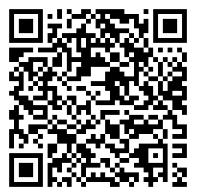
Realities of Child Abuse and Neglect
1. There is no excuse for child abuse. No culture supports harming children.
2. Research shows that child abuse occurs in all racial, ethnic, socioeconomic and cultural sectors of society.
3. Research indicates that developmentally appropriate education can prevent some instances of child abuse. By supporting them to develop skills, attitudes and behaviors that keep themselves safe from perpetrators.
4. Research indicates that 90% of abuse is from domestic causes and is committed by individuals known to the child.
International schools are bound by laws of the host country and must be knowledgeable and compliant with the student protection laws in the host country.
Students Reporting Suspected Sexual Abuse and Next Steps
Students are encouraged to report incidents for which they themselves may be the victims by disclosing the circumstances verbally or in writing with any school employee. The employee must report the disclosure to a member of the Student Safeguarding Advisory Committee and/or Safeguarding Lead immediately, and in any event within 24 hours. Employees will be asked to complete the Safeguarding Reporting Form (Addendum E).
Students who wish to remain anonymous may report concerns via any of the “safety boxes” located in public locations across campus including the Elementary, Middle and High School wings. These boxes will be checked periodically by the Student Safeguarding Advisory Committee.
In either case, the Student Safeguarding Advisory Committee will convene, add the concern to their register and to take suitable action as per the POCSO Act of 2021, including reporting the matter to the relevant local authorities.
Safety Box Map

Adults’ Reporting Procedures
All adults are obligated to promptly report any concerns they may have. These concerns may include instances of sexual or non-sexual abuse, neglect, feelings of discomfort, unease, harassment, inappropriate or unprofessional behaviors, or any other behaviors that may indicate a potential safeguarding issue. It is not the responsibility of individual adults to investigate, gather evidence, or determine if abuse has occurred. All concerns raised will be investigated by the safeguarding team and/or appropriate authorities. Those reporting concerns have the option to request confidentiality, and they are protected under the AISC’s policy for reporting wrongdoing.
Reporting procedures for concerns are as follows:
If your concern is about a student:
• Concerns need to be reported immediately to either the section counselor or safeguarding lead.
• If neither are available you can report to a principal and they will contact the counselor and/or safeguarding lead.
• Reports should be made in person and a reporting form should also be completed
If your concern is about an adult/employee:
• Concerns need to be reported immediately to either the section principal and/or safeguarding lead.
• Reports should be made in person and a reporting form should also be completed
If your concern is about a Principal or Assistant Principal:
• Concerns need to be reported immediately to either the Head of School and/or Safeguarding Lead.
• Reports should be made in person and a reporting form should also be completed
If your concern is about the Head of School:
• Concerns need to be reported immediately to the Board Chairperson
• You can email the Board asking for a confidential meeting to express concerns.
• Reports can also go through the Safeguarding Lead which will report to the Board Chairperson.
• With safeguarding cases, a reporting form should also be completed
Response to Allegations Made Involving an AISC Employee
In the event that a non-sexual abuse or neglect allegation involves an employee of AISC, the same steps described above will be followed in conjunction with the following actions.
Inquiry
• AISC employees who are involved in or formally accused of abuse will immediately be removed from any contact with students and the school administration will quickly set up an inquiry into the situation (as per Board Policy 6.810).
• The Head of School will determine who will lead the inquiry. This leader of the inquiry will conduct a prompt, confidential and thorough inquiry to determine whether reasonable grounds exist to believe that abuse occurred. A written report will be submitted to the Head of School.
• The leader of the inquiry will forward reports to the Head of School. If an employee in the reporting chain is implicated, the report should go to the next level. If the Head of School is implicated, the Board Chair should be informed.
Consequences
• If the inquiry indicates that reasonable grounds do not exist to support allegations of abuse, a statement to that effect will be given by the Head of School to the AISC employee in question.
• AISC employees who violate any of the regulations above will, at a minimum, be officially reprimanded in writing. This will take place in a meeting involving the Head of School, and/or section principal. The first offense may lead to immediate termination depending on the circumstances.
• If inappropriate behavior did exist but does not constitute abuse, the perpetrator will be subject to appropriate disciplinary consequences.
• If the inquiry indicates that reasonable grounds do exist to believe that abuse has occurred, the Head of School will submit a copy of the report to the board chair.
• The Head of School will determine suitable disciplinary action, which could result in termination of employment. Legal action by the Indian police is also a possible consequence outside the purview of these regulations.
Student Protection Incident Response for Employee
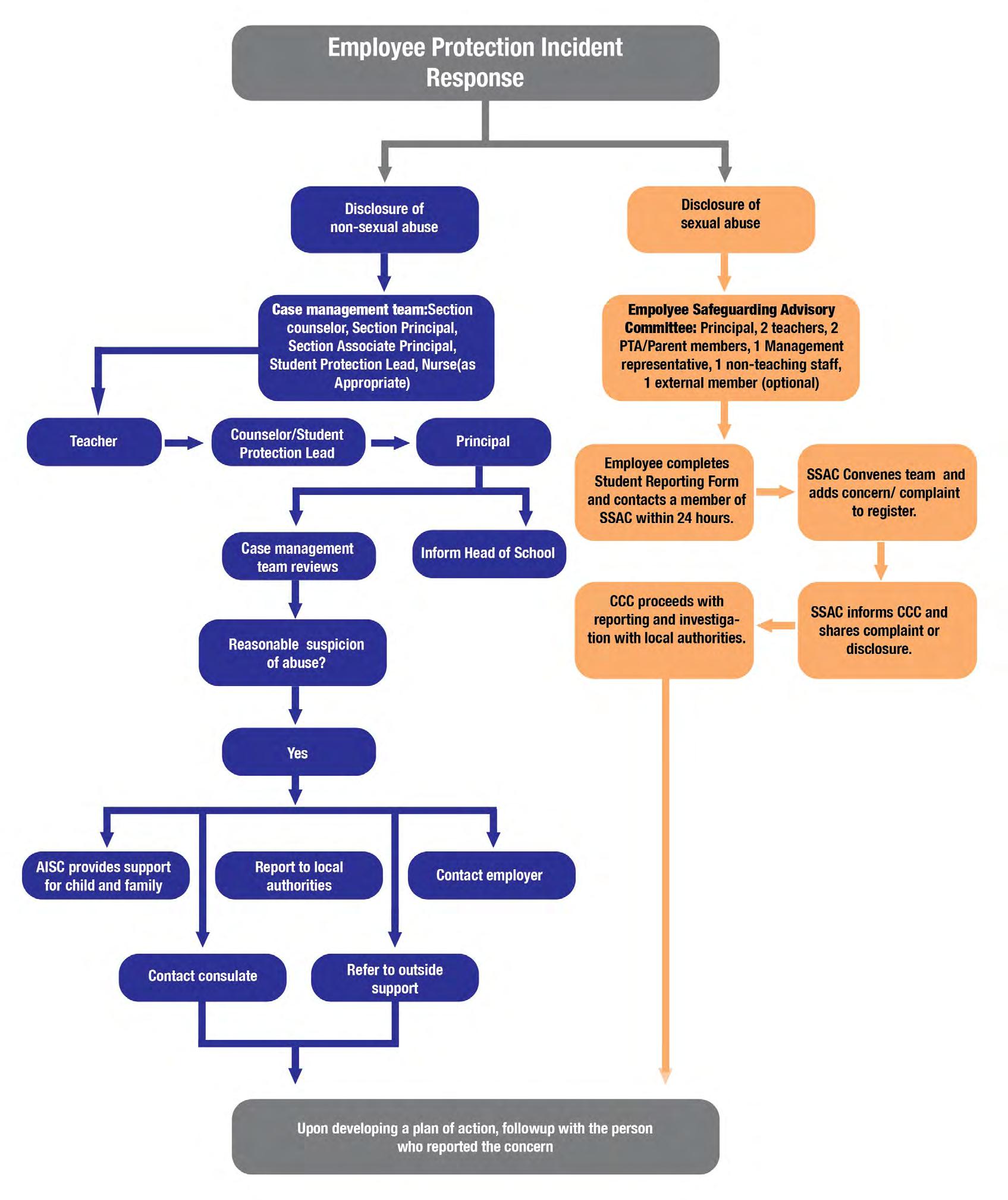
Student Protection Incident Response for Sexual and Non-Sexual Abuse Allegations
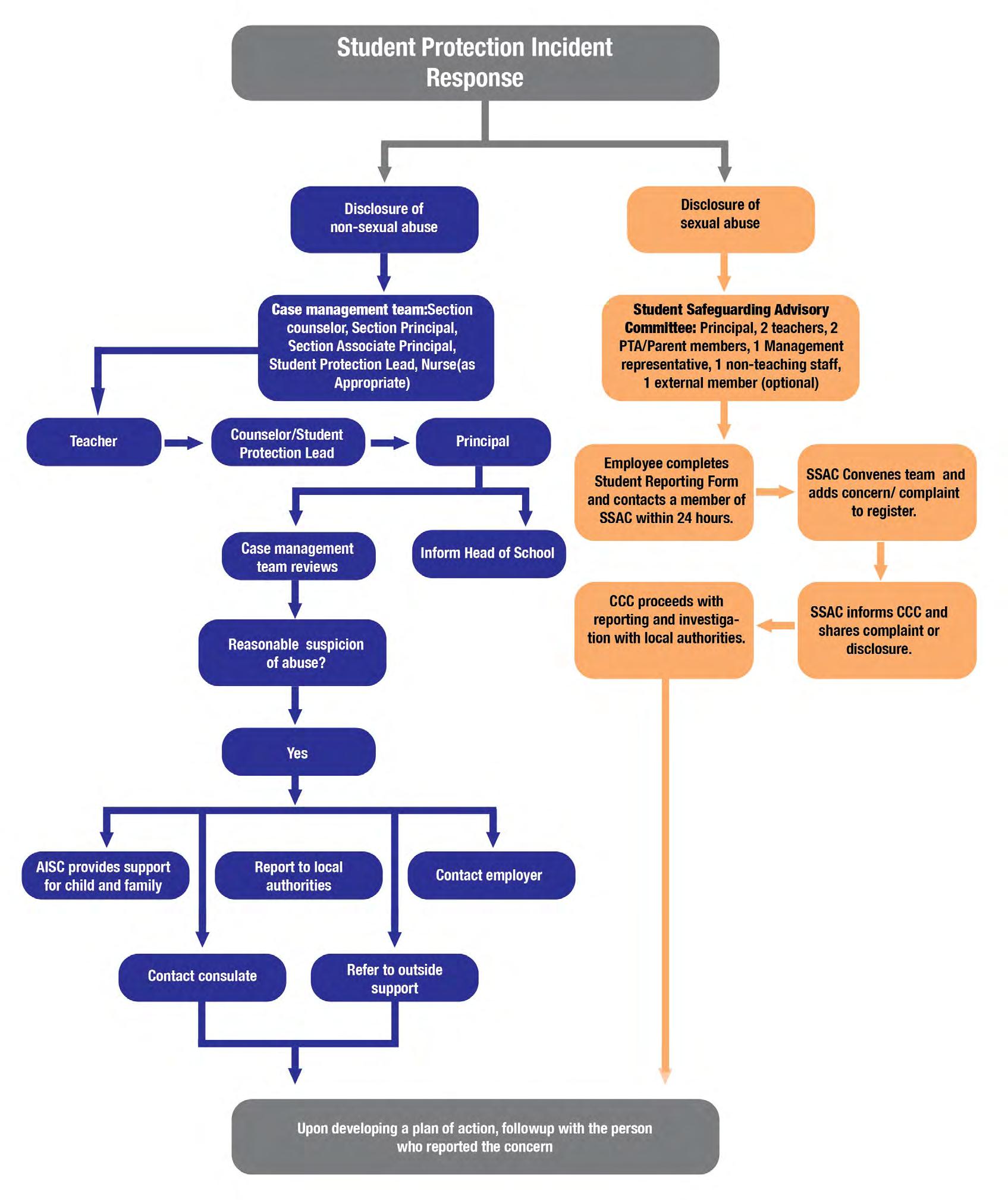
Supporting a Child or Young Person Who Discloses Abuse
Adults working with children and young people must understand and know how to respond appropriately to disclosures from students, knowing that it is often very difficult for them to disclose abuse. Children and young people often cannot easily talk about an abuse problem because they may:
• Try to “forget” in order to cope
• Worry they will lose the love of their parents or friends
• Fear the shame of abuse or getting in trouble for telling (especially older children)
• Fear they will be blamed, as adults tend to be believed more than children
• Be under threat by the offender to harm them or their family if they tell
It is important that you remain calm and in control of your feelings in order to reassure and support the child or young person. If a student asks to speak with you, find a neutral setting where you can have quiet, and few interruptions.
Possible ways you can show your care and concern:
• Listen carefully to what the child or young person is saying.
• Refrain from expressions of panic or shock.
• Reassure the child or young person that you believe them and that to disclose was the right thing to do.
• Acknowledge that it is hard to talk about such things.
• Indicate what you will do, i.e. that you will talk to someone who can give you some advice about what should happen next.
• Reassure the child or young person that they are not to blame (only if the child indicates this is what they believe).
• If you are not in a position to answer all the questions that a child or young person may have, explain that you don’t know but will pass on their questions or concerns to the relevant person.
You will not be helping the child if you:
• Probe the student into telling details; instead, just listen, letting him/her explain in his/her own words;
• Express anger or disgust about the alleged abuser;
• Make promises you cannot keep, such as promising that you will not tell anyone; or promises to the student that things will get better;
• Seek further details beyond those that the child or young person freely wants to discuss;
• Confront the abuser.
Remember that quizzing children about details may be interpreted as disbelief. Your role is to support and listen to the child or young person, not to conduct an investigation.
Respect the student’s confidence. Share with the Safeguarding Lead, a counselor, or principal, but limit information to other staff. Write down basic information, in the student’s words if possible. Explain to the student that you must tell someone else to get help. Try to let the student know that someone else also will need to talk with him/her and explain why.
If the student does not want to go home, this should be considered an emergency. Report to a counselor immediately.
If you suspect abuse, but the child or young person has not told anyone, speak to your section counselor, principal and/or the Safeguarding Lead for support.
Documenting Suspected Non-Sexual Abuse/Neglect
All reporting adults will be asked to complete the safeguarding reporting form (Addendum E) when they report concerns to a counselor, principal or the Safeguarding Lead. The form serves the purpose of recording concerns factually.
The following information will be collected and filed in the secured digital CPOMS system.
• Notes from Case Management Team discussions
• Emails that pertain to the case
• Description of action taken
• Correspondence with the student
• Correspondence with the student’s family
• Correspondence with external agencies
Documenting Suspected Sexual Abuse
All reporting adults will be asked to complete the student protection reporting form (Addendum E). The employee will contact a member of the Student Safeguarding Advisory Committee immediately of the disclosure. The employee will submit the Addendum E to the SSAC committee who will convene immediately. The form serves the purpose of recording concerns factually.
The following information will be collected and filed in the secured system of CPOMS and the register that is maintained by the Student Safeguarding Advisory Committee.
• Emails that pertain to the case
• Description of action taken
• Correspondence with the student
• Correspondence with the student’s family
• Correspondence with external agencies
Role and Responsibilities
School Leadership
• Promotes and champions child safeguarding in the school.
• Actively participates in the safeguarding council.
• Follows and provides guidance on safeguarding cases.
• Attends planning and risk assessment meetings for major safeguarding meetings and helps to ensure cases are managed in the proper way.
• Consults with lawyers and receives guidance on safeguarding cases.
• Advocates for all in the community.
• Completes portions of the action plan that pertains to their job.
• Ensures administration follows proper procedures with safeguarding cases and documentation.
• Helps to manage all allegations against an employee in conjunction with the Head of school and/or Board Representative and/or other Administrator based on the situation.
Community Safeguarding Handbook 2025 - 2026
• Consults with and gives information to the board of directors.
• Works with the HR Director/SLT to ensure that Safe Recruitment is followed by regular checks of the school’s single central recruitment record.
• Maintain confidentiality on any information about a student and possible safeguarding concerns.
Safeguarding Lead and Deputy Safeguarding Leads
• Promotes and champions child safeguarding in the school .
• Creates guidelines for the response to any safeguarding issue.
• Monitors the progress of each case to its conclusion if not directly involved.
• Convenes review meetings of the safeguarding council
• Leads monthly meetings to follow through on the action plan.
• Provides summaries of any child safeguarding issues, including data, training, budget and system recommendations to the SLT and Head of School
• Ensures a confidential, centralized procedure exists for recording and reporting safeguarding issues.
• Ensures Safeguarding case files for individual incidents are managed appropriately according to the school guidelines.
• Monitors CPOMS system to ensure proper use.
• Update the board representative on cases and progress so they can report to the school board.
• Maintain confidentiality on any information about a student and possible safeguarding concerns.
Staff and Volunteers
• Promotes and champions child safeguarding in the school.
• Attends and participates in all safeguarding trainings
• Report all safeguarding concerns to the section counselor immediately
• Comply with any inquiry that may occur where their input is needed
• Follow the code of conduct signed at the beginning of the year.
Students
• Follow school rules to help ensure safety of all.
• Be kind to everyone in the AISC community
• Report any safeguarding concerns to the section counselor/principal
• Respect confidentiality by not engaging in gossip about other students
Parents
• Understand and follow AISC safeguarding expectations
• Create a safe home environment for their children
• Report any safeguarding concerns or other concerns directly to the school section counselor or principal.
• Respect confidentiality by not engaging in gossip about other families/ students
• Practice due diligence when hiring outside help for your home such as housemaids, drivers, nannies.
Safeguarding Teams
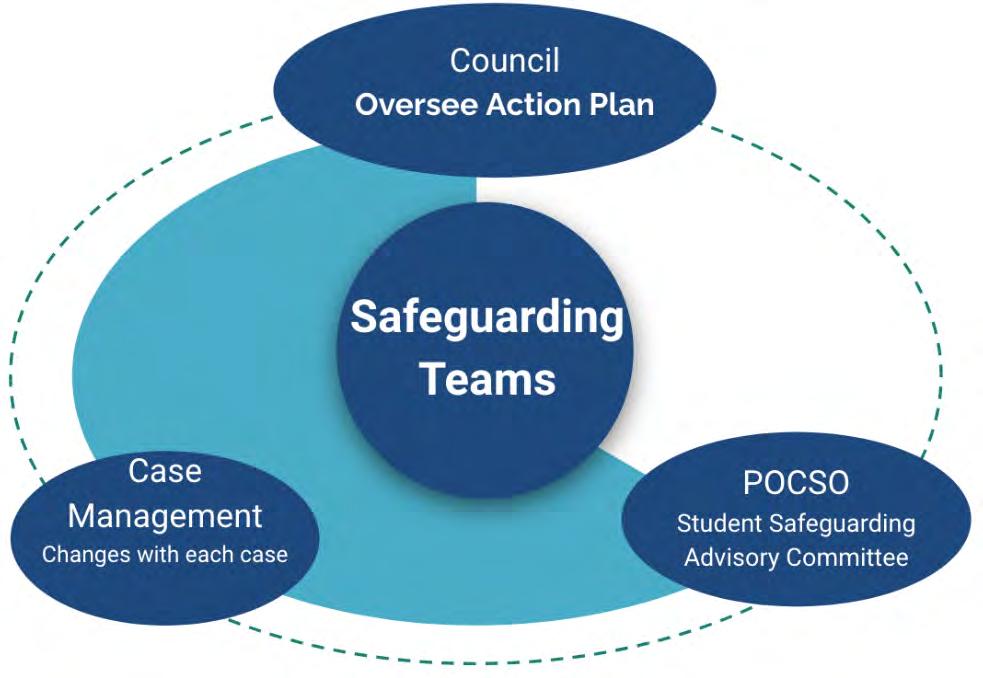
Student Safeguarding Advisory Committee
The Student Safeguarding Advisory Committee is responsible for ensuring adherence to the Indian POCSO law and will oversee all cases of sexual abuse and sexual harassment. This committee ensures that all procedures are followed correctly and that each case is managed in compliance with legal requirements.
Case Management Team (CMT)
The Case Management Team is dedicated to ensuring the safety of students and adheres to school policies and procedures in all non-sexual abuse or harassment safeguarding cases. The composition of the team will vary depending on the school section of the student involved, but a Safeguarding Lead will be a member of every Case Management Team to provide consistent oversight and support.
Safeguarding Council
The Safeguarding Council, led by the school’s Safeguarding Lead, ensures that AISC maintains an up-to-date and comprehensive approach to safeguarding. This group is responsible for the review, planning, and implementation of the Safeguarding Action Plan, promoting a proactive and effective safeguarding strategy.
Preventative Safeguarding Measures
Screening and Criminal Background Check
At AISC, preventing student abuse involves thorough screening of potential employees, including background checks for criminal and sexual offender records. We reserve the right to conduct additional checks at any time during employment, and any misrepresentations or omissions in applicant information may lead to termination.
Employee Student Protection Agreement
All employees are required to review the safeguarding policies and handbook annually and to sign a Code of Conduct. This agreement confirms their understanding of and commitment to the appropriate behavior and expectations related to their employment and safeguarding responsibilities.
Training for Employees and Contractors
All employees of AISC participate in annual training to build awareness of student protection concerns, types of abuse and neglect, signs/symptoms, prevention, policies and laws, reporting process, student curriculum and community resources. New faculty and staff that commence during the school year are trained before commencing work with students.
Student Education
Research shows that age-appropriate personal safety/abuse prevention programs for children are successful when they are based on the most current research in prevention education.
Student protection education aims to assist students to develop skills to:
• Recognize abuse and tell a trusted adult about it (or report abuse via a “safety box”).
• Understand what is appropriate and inappropriate touching
• Understand what are safe and unsafe secrets.
• Understand ways of keeping themselves safe.
Given the importance of protecting all students at AISC, we do not seek permission from parents to have their child participate in this curriculum. We
encourage parents/caregivers to seek further clarification if required and to provide their teacher or counselor with any relevant information about their child that could alleviate any concerns.
Dependent on grade level, students will receive instruction in this curriculum during their homeroom class, health class, advisory, or HS seminar.
Parent Education
Student protection at school is a partnership with parents. Through the PCA and school-organized parent coffees, abuse education and training lessons will be provided. Topics covered may include:
• Understanding of school and governmental policies and procedures related to abuse and neglect
• Understanding of the School’s student protection curriculum
• Signs and symptoms of abuse
• Awareness of risks to which students are exposed
• How to talk to children and prevention strategies
• Handling disclosure and reporting as a parent
• Community resources
AISC Secure Campus
To ensure student safety, any adult identified as a potential risk will be denied access to the AISC campus and drop-off area. The assessment of potential risk will be conducted by the Safeguarding Lead, Director of Teaching and Learning, Chief Business Officer, and Head of School. This assessment is for student protection purposes and does not constitute a legal judgment.
Supervision of Locker Rooms
ILocker rooms are supervised in line with safeguarding guidelines. Employees do not remain in locker rooms except in early years settings where assistance with changing may be required. In emergency situations, staff may enter locker rooms, but all employees are trained to ensure that their entry is conducted with respect for student safety and privacy at all times.
Supporting Diverse Sexual Identities, Gender Identities, and Gender Expressions
Worldwide data collated by UNESCO in 2016 indicates that students who are perceived not to conform to prevailing sexual and gender norms, including those who are lesbian, gay, bisexual, transgender, intersex or queer (LGBTIQ) are more vulnerable to discrimination, harassment and/or bullying in school. With heightened stressors like discrimination, harassment and bullying, LGBTIQ students are also more likely to experience negative educational outcomes. These guidelines, for supporting students, staff and community members with diverse sexual identities, gender identities and gender expressions, are mission-aligned and based on practices most consistently identified in current research and educational literature as effective and appropriate in the creation of learning environments that are equitable, caring respectful and safe for all members of the school community.
Studies have shown that creating a supportive environment for LGBTIQ students improves educational outcomes for all students, not just those who may identify as LGBTIQ. To create a supportive environment for LGBTIQ students is also in line with one of the core values at our school that “each person has intrinsic value, worthy of dignity and respect.”
Monitoring and Review
At AISC, monitoring and reviewing safeguarding policies and procedures are imperative to uphold the highest standards of safety and care for all members of our community. With a diverse population from various cultural backgrounds, it is essential to regularly assess and adapt our protocols to address the unique needs and challenges that arise. By consistently monitoring and reviewing our policies, we can identify any gaps or areas for improvement, ensuring that our approach remains robust and responsive to emerging risks or concerns. Ultimately, this proactive approach demonstrates our unwavering commitment to creating a nurturing environment where every student feels secure, respected, and empowered to thrive.
As part of this review process:
• 2023-2024 an internal audit was conducted
• Spring 2024 a detailed action plan was developed from the audit
• 2024/2025- Safeguarding Council is added to help implement the action plan
• 2024/2025 Deputy safeguarding leads were appointed
• May 2024 Safeguarding Handbook was updated.
• 2024/2025–Safeguarding Handbook will go through a complete revision with added policies
• 2024/2025 Trainings and education is being updated
Addenda
Addendum A: Certificate of Guardianship
This form must be completed anytime there is a change of guardianship for a student because of family changes, travel, business, etc.
Addendum B: Counseling Compliance Requirement
Our Mission and Core Values reflect a school community dedicated to the development of each and every student of the school. At AISC, we are committed and have a duty to care, protect and preserve the safety, health and well-being of all students so that they can make their unique contribution to a diverse and dynamic world. In order to effectively maintain the safety of all students, AISC counselors and administrators have the right in all situations to speak with students privately and confidentially. Should a parent refuse to allow a school official to speak with a child, the school reserves the right to take appropriate measures. In extreme circumstances, measures could include, but are not limited to, denying the student access to the school premises until such time that the family agrees to appropriate private and confidential conversations or counseling. These measures would be taken in the best interest of students’ safety and well-being.
Addendum C: Parent Code of Conduct
All parents are required to sign this via RaptorNet.
Addendum D: Safeguarding Reporting Form (Reporter)
(Submit to an AISC counselor, principal or Student Protection Lead) Anytime there is a concern, this form must be completed and submitted immediately to the Section counselor and/or safeguarding lead. If the
counselor of Safeguarding lead cannot be found it should be submitted to the section principal.
Addendum E: Visitor Guidelines
These guidelines must be reviewed with all visitors to AISC and signed by the visitor.
Addendum F: Virtual Learning Faculty Guidelines for Student
To ensure student safety during virtual learning, all online sessions must be recorded and stored in the cloud for review by the Student Safeguarding Advisory Committee. Faculty must also maintain professional boundaries and have professional guidelines they must adhere to with virtual learning. All concerns from an employee about a student or from a parent need to be promptly reported.
*Parents will be given the opportunity to opt out of 1-1 student calls with faculty. Relevant faculty will be made aware of this if it occurs and will be supported with identifying other avenues for supporting the student’s learning
